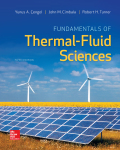
a)
The final temperature of the helium
a)
Explanation of Solution
Given:
The volume of the nitrogen is 0.2 m3.
The mass of the helium
The initial temperature of the gases
The initial pressure of the gases
The final temperature of the nitrogen is 500°C.
The final pressure of the helium
Calculation:
Refer the Table A-2, “Ideal-gas specific heats of various common gases table”,
The specific heat ratio
Write the relation between the pressure and temperature in the isentropic process.
b)
The final volume of nitrogen
b)
Explanation of Solution
Refer the Table A-2, “Ideal-gas specific heats of various common gases table”,
The gas constant for the helium gas is
Calculate the initial volume of helium
Calculate the final volume of helium
Calculate the final volume of the nitrogen
Thus, the final volume of nitrogen is
c)
The heat transferred to the nitrogen.
c)
Explanation of Solution
Refer the Table A-2, “Ideal-gas specific heats of various common gases table”,
The gas constant for the helium gas
The specific heat constant the helium gas
The gas constant for the helium gas
The specific heat constant the helium gas
Calculate the mass of the nitrogen
Calculate the temperature of the nitrogen
Calculate the change in internal energy of the nitrogen.
Calculate the change in internal energy of the Helium.
Calculate the heat transferred to the nitrogen using the energy balance equation for the system.
Thus, the heat transferred to the nitrogen is
d)
The entropy generation during the process
d)
Explanation of Solution
Write the expression for the entropy generation
Thus, the entropy generation during the process is
Want to see more full solutions like this?
Chapter 8 Solutions
EBK FUNDAMENTALS OF THERMAL-FLUID SCIEN
 Elements Of ElectromagneticsMechanical EngineeringISBN:9780190698614Author:Sadiku, Matthew N. O.Publisher:Oxford University Press
Elements Of ElectromagneticsMechanical EngineeringISBN:9780190698614Author:Sadiku, Matthew N. O.Publisher:Oxford University Press Mechanics of Materials (10th Edition)Mechanical EngineeringISBN:9780134319650Author:Russell C. HibbelerPublisher:PEARSON
Mechanics of Materials (10th Edition)Mechanical EngineeringISBN:9780134319650Author:Russell C. HibbelerPublisher:PEARSON Thermodynamics: An Engineering ApproachMechanical EngineeringISBN:9781259822674Author:Yunus A. Cengel Dr., Michael A. BolesPublisher:McGraw-Hill Education
Thermodynamics: An Engineering ApproachMechanical EngineeringISBN:9781259822674Author:Yunus A. Cengel Dr., Michael A. BolesPublisher:McGraw-Hill Education Control Systems EngineeringMechanical EngineeringISBN:9781118170519Author:Norman S. NisePublisher:WILEY
Control Systems EngineeringMechanical EngineeringISBN:9781118170519Author:Norman S. NisePublisher:WILEY Mechanics of Materials (MindTap Course List)Mechanical EngineeringISBN:9781337093347Author:Barry J. Goodno, James M. GerePublisher:Cengage Learning
Mechanics of Materials (MindTap Course List)Mechanical EngineeringISBN:9781337093347Author:Barry J. Goodno, James M. GerePublisher:Cengage Learning Engineering Mechanics: StaticsMechanical EngineeringISBN:9781118807330Author:James L. Meriam, L. G. Kraige, J. N. BoltonPublisher:WILEY
Engineering Mechanics: StaticsMechanical EngineeringISBN:9781118807330Author:James L. Meriam, L. G. Kraige, J. N. BoltonPublisher:WILEY





